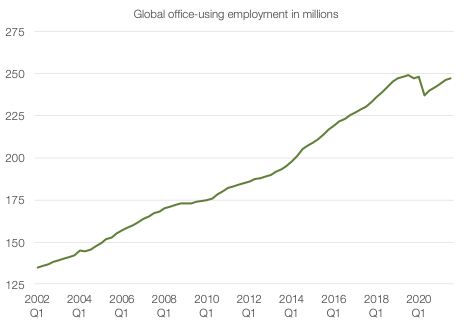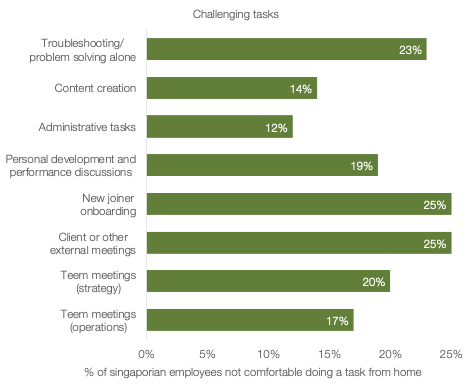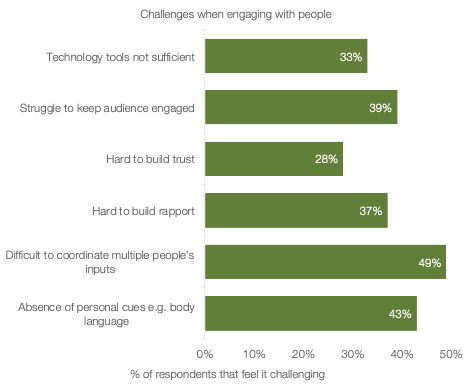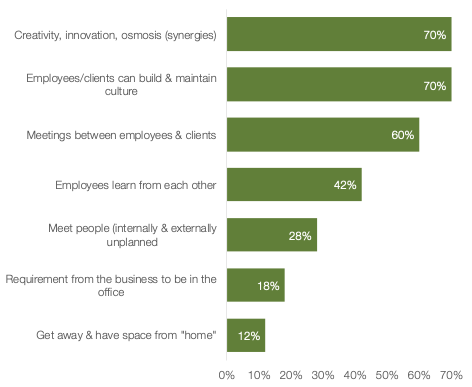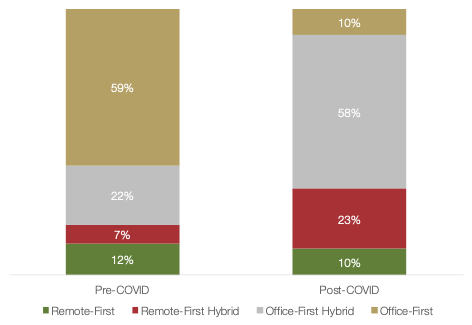The office returns stronger than ever before
Until a few years ago, there was very little movement in the market for office space. After the open-plan office landscape became standard in the late 20th-century, the market trend was mostly about constantly optimizing the density of workplaces because of continuously increasing rents in most cities across the world. Only recently, with the advent of co-working spaces, a certain dynamic emerged.
Co-working office spaces should not only promote creative collaboration but also offer more flexible rental models. In the midst of such an emergence of co-working spaces, the onset of COVID-19 has instantly turned the office landscape upside down. Firms were forced to let their employees work from home whenever possible. The home office was quickly praised as a new ideal form of workplace.
Figure 1: Office-using employment is on a long-term rise
Continue working from home?
As employees had no choice during the lockdown but to finally use the readily available telecommunications technologies, many teams were surprised with how efficient it was to work from home. Meetings were suddenly held as videoconferences, and many business trips and daily commuting times were saved.
However, the home office also has certain drawbacks. Spontaneous interactions are missing, and a creative process in a team is difficult to manage from a distance. In particular, when new employees need to be trained and familiarized, it is a challenge to do this via the home office. In addition, it is extremely difficult to impart knowledge and values such as a company culture or ethics from a distance, and team dynamics are also experienced much more directly in an office rather than from home. When it comes to management meetings, videoconferencing often works well for smaller groups, where the participants already know each other, but for larger groups or participants who are unfamiliar with each other, the physical exchange is difficult to replace.
The home office experience is also mixed from the viewpoint of the employees' well-being. While some employees, especially younger ones, appreciate independence and feel a better work-life balance and higher satisfaction when working from home, for others the perceived stress in the home office and the risk of burnout has increased. The lack of spatial separation of work and private life can quickly lead to uncontrolled overtime, and can also have an impact on the personal living environment. A household with several people in a small space, as is often the case with young families or in large metropolitan areas, usually does not offer a reasonable alternative to an office. Various recent surveys provide valuable insight into the advantages and disadvantages of working from home, perceived by both employers and employees.
Figures 2 and 3: Challenges when working from home – a survey from Singapore
Don't save on quality office space
For the longer term, employers should look beyond the obvious pros and cons of the home office. On the one hand, employers fear that working from home will, over time, become less efficient due to a lack of control and interaction. On the other hand, employers hope to save costs by reducing office space. However, it is often forgotten that the office rent per employee is low compared to an employee's salary, usually well below 10%. Almost every investment in offering an attractive workplace is worthwhile as long as it generates additional productivity or motivation for employees, or if it helps to attract and retain talent.
It is likely that merely offering a workstation to employees will not be insufficient, but quality office space for teams encourages them to meet, develop business, and build a corporate culture.
Indeed, for some tasks, efficiency seems to increase when working from home, but for other, more interactive tasks, efficiency has decreased. Ideally, the positive effects of working from home can be retained without foregoing the advantages of a shared workspace. It is becoming apparent that companies are increasingly willing to offer employees options for how to work. Moreover, employees increasingly prefer to have more flexibility in terms of choosing between working partly in the office and partly from home.
In the wake of the COVID-19 lockdowns, it is interesting to note that the technology sector has generated higher demand for additional space, as technology firms are taking advantage of attractive office spaces to attract talent. At the same time, however, these firms also offer the opportunity to work from home, thus signaling to their employees a high degree of freedom of choice and flexibility regarding the workplace.
Options are in demand
More and more companies will move to a hybrid workplace, which allows working from home but also offers optimal opportunities for working in a team. Core hours or work weeks can be defined, based on which the physical presence in the office is expected. During these time slots, ideas are exchanged, and concepts and strategies are developed, and young employees learn how regular business works by working with their more experienced colleagues.
In addition to a company's own flexible office space, external co-working spaces are likely to become more popular. This form of office is an interesting alternative, especially in industries where people work without confidential data. In creative professions, it can be useful to exchange ideas with people from outside the company to explore new horizons.
In addition to freelancers, startups, and small companies, which often cannot afford their own offices, there is also increasing demand from large companies for co-working spaces, as they appreciate the variable space available in addition to their fixed office space. This can save costs, for example, for conference rooms that would otherwise be rarely used, or for expensive space in central locations. With open office landscapes and meeting zones, such an option can offer employees some variety and an innovation-promoting environment along with good networking opportunities.
Offering a flexible and attractive workplace is becoming increasingly important in the "war for talents," while talents will increasingly demand a combination of home office and an attractive office environment for working in a team. At the same time, simple, repetitive work will probably be increasingly moved to more affordable locations. The home office will thus become a complement to the office, not a substitute.
The "hotelization" of office space
The rental model will also be put to the test. Tenants are willing to pay a surcharge for co-working spaces as long as they can claim a high degree of flexibility with regard to the actual space used. Flexibility is of great benefit, especially in times of high uncertainty. The development toward shorter contract periods and early termination rights, combined with an increased tenant turnover, was already noticeable in the office sector before COVID-19.
In the co-working sector, the traditional rental model has been replaced at the end user's request, as it is possible to book a workplace at short notice and for a short term only. However, co-working operators will also want to negotiate new models with landlords as the maturity transformation risks resulting from the disproportion between short-term uses and the operators' long-term rental contracts are simply too high. As a result, many co-working operators are setting up a separate special-purpose vehicle for each rented space, which they could allow to default without endangering their other sites.
A more desirable solution for operators and landlords would be a rental model in which their interests are aligned. One possibility is performance-based management contracts, similar to those in the hotel industry, in which income from end users is shared. Larger operators can also build a brand, which in turn can become an important asset in the negotiation.
Flexibility is the new sustainability
The workplace of the future will increasingly be a platform for physical and virtual connectivity, creating an environment in which people can work efficiently and with motivation. The time in the physical office will increasingly be used for creative exchange, so suitable rooms and amenities need to be offered in office spaces. In return, inflexible office spaces and buildings will be less in demand and likely decrease in value. Employees and customers will increasingly see the supply of office space as a service for their ideal use of space.
Irrespective of whether the scenario described above materializes, whether the traditional open-plan office continues to dominate, or even if the home office becomes widely accepted, flexibility and the possibility of converting office buildings is more important today than ever.
Disclaimer
© 2025 Asia Green Real Estate AG, Switzerland. No warranty can be accepted regarding the correctness, accuracy, uptodateness, reliability and completeness of the content of this document. Asia Green Real Estate expressly reserves the right to change, to delete or temporarily not to publish the contents wholly or partly at any time and without giving notice. This document as well as its parts is protected by copyright, and it is not permissible to copy them without prior written consent from Asia Green Real Estate. This material does not take into consideration the specific investment objectives, financial situation or particular needs of any person that enters into a relationship with Asia Green Real Estate. No representation or warranty, expressed or implied, is made by Asia Green Real Estate regarding future performance. This material is not directed to, or intended for distribution to or use by, any person or entity that is a citizen or resident of, or located in, any locality, state, country or other jurisdiction where such distribution, publication, availability or use would be contrary to law or regulation or subject Asia Green Real Estate to any registration requirement. The document may contain forward-looking statements that reflect Asia Green Real Estate's current views with respect to, among other things, future events and financial performance. Any forward-looking statement contained in this material is based on our current estimates and expectations and are subject to various risks and uncertainties.
Our complimentary publications inform you about current developments in the Asian real estate market and key trends in the real estate industry. Sign up to receive them automatically.

